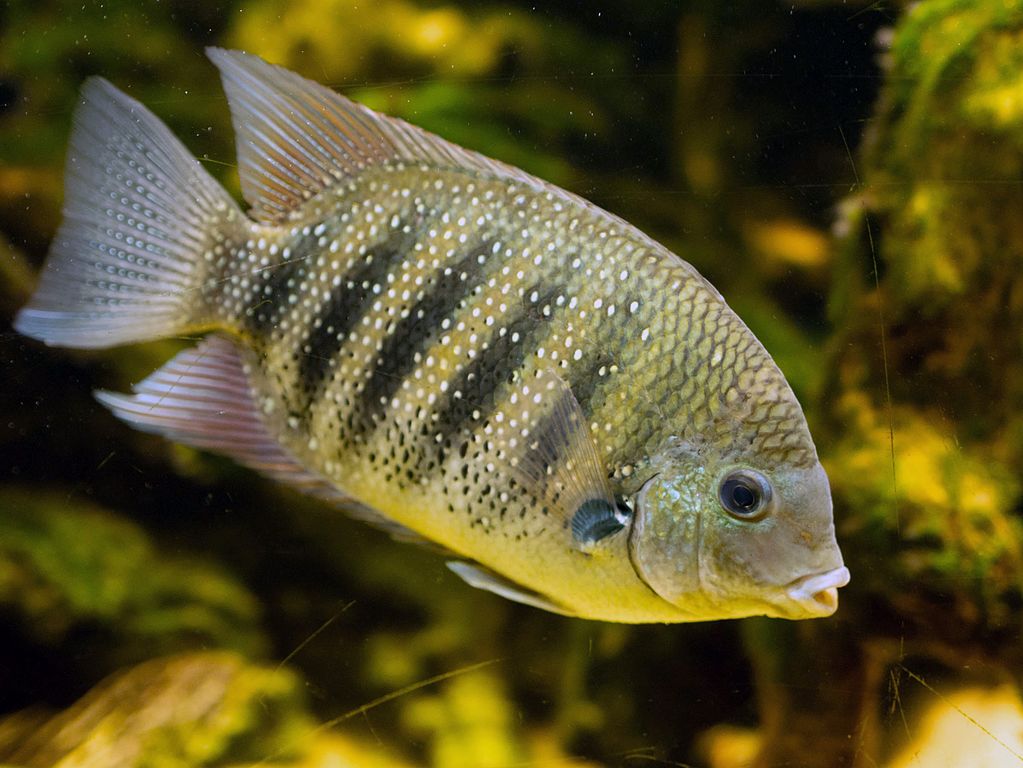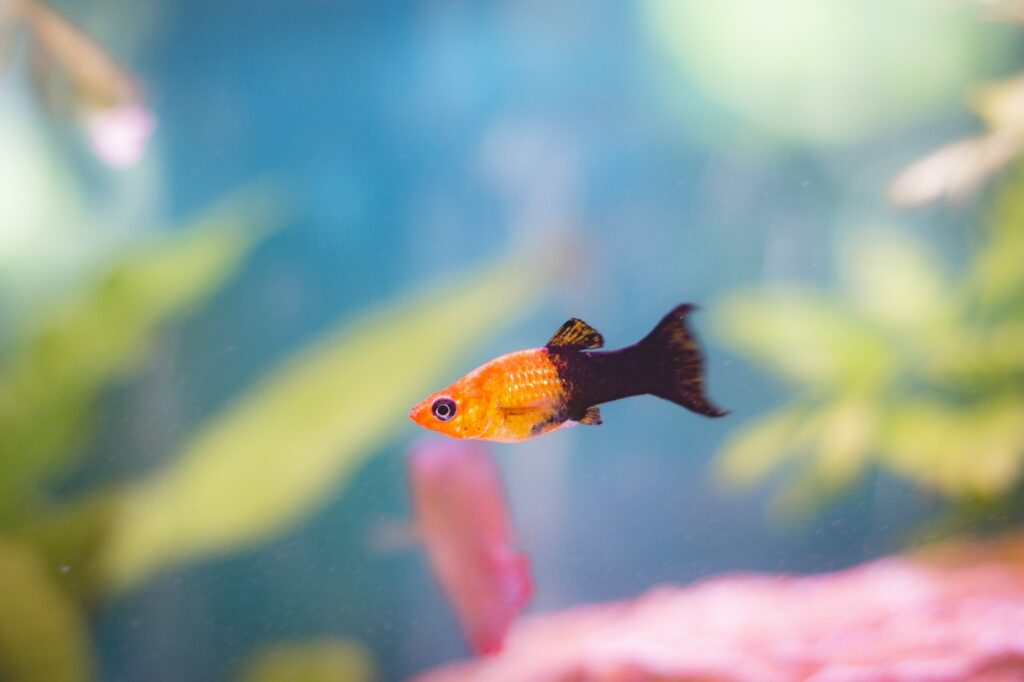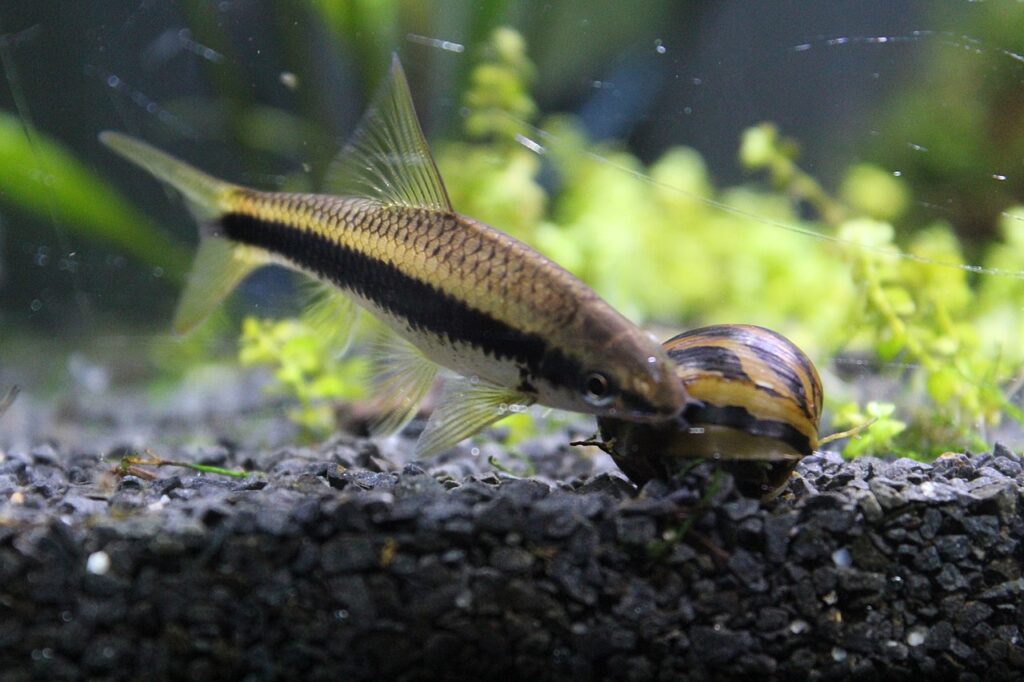The Green Chromide, scientifically known as Etroplus suratensis, is a fascinating fish that calls the brackish waters of India and Sri Lanka home. This oval-shaped swimmer, with its greenish-gray body adorned with dark stripes, is a sight to behold. Belonging to the cichlid family, it shares kinship with other popular aquarium fish like angelfish and discus.
Table of Contents
What makes the Green Chromide truly special is its ability to thrive in both fresh and saltwater environments. Imagine a fish that can swim from rivers to coastal lagoons without missing a beat! This adaptability has earned it the nickname “pearlspot” due to the pearly white spots that shimmer on its scales.
The scientific name Etroplus suratensis has an interesting story. “Etroplus” comes from Greek words meaning “belly” and “arms,” referring to the fish’s long spiny anal fin. “Suratensis” points to Surat, a city in India where the fish was first described.
In the wild, these fish are bottom-dwellers, happily munching on algae, small insects, and plant matter. They’re social creatures, often seen swimming in groups. But don’t let their peaceful nature fool you – they can be quite territorial when it comes to breeding time!
Speaking of breeding, Green Chromides are devoted parents. Both mom and dad work together to care for their eggs and fry. They even produce a special mucus that serves as the first meal for their babies. Talk about a nutritious breakfast!
A study published in the Journal of Fish Biology revealed something fascinating about these fish. Researchers found that Green Chromides in Singapore have adapted to living in completely freshwater habitats, challenging the belief that they always need salt in their water.
Fun fact: In Kerala, India, the Green Chromide is so beloved that it was named the official state fish in 2010. The following year was even declared “The Year of the Karimeen” (another local name for the fish).
From ancient lagoons to modern aquariums, the Green Chromide has swum its way into the hearts of fish enthusiasts worldwide. Its ability to adapt, its striking appearance, and its interesting behaviors make it a true gem in the underwater world.

Green Chromide Key Information
The Green Chromide, a stunning fish with a captivating appearance, boasts a greenish-gray body adorned with dark vertical stripes. Its scales shimmer with pearly white spots, giving it a jewel-like quality in the water. As the fish matures, it develops a beautiful golden hue on its belly and fins, creating a striking contrast against its darker upper body. This color pattern not only makes it a visual delight but also serves as effective camouflage in its natural habitat.
| Family | Cichlidae |
| Origin | India and Sri Lanka |
| Price | Moderate |
| Common Names | Pearlspot, Green Chromide, Karimeen |
| Variants | Wild-type |
| Ideal Tank Size | 50 gallons or larger |
| Water Parameters | pH 7.0-8.5, Temperature 72-82°F (22-28°C), Hardness 5-20 dGH |
| Lifespan | 5-7 years |
| Full Size | Up to 12 inches (30 cm) |
| Natural Environment | Brackish waters, coastal lagoons, estuaries |
| Behavior | Bottom to middle dweller, territorial during breeding |
| Habitat Preference | Brackish water with plenty of hiding spots |
| Aquarium Decoration | Rocks, driftwood, hardy plants, open swimming areas |
| Ideal Tank Mates | Other brackish water fish, mollies, archerfish |
| Fish to Avoid | Aggressive or much smaller species |
| Best Foods/Diet | Omnivore: algae, small insects, plant matter, commercial pellets |
| Disease | Susceptible to common freshwater fish diseases |
| Sex-switch | Not known to change sex |
| Gender Differences | Males slightly larger with more vibrant colors |
| Care Level | Moderate |
| Breeding Level | Moderate to difficult |
Ideal Tank Mates for Green Chromide
The Green Chromide (Etroplus suratensis) is a peaceful and adaptable fish that can thrive in both freshwater and brackish environments. When selecting tank mates for this species, it’s important to choose fish that share similar water parameter requirements and have compatible temperaments. Here are 10 ideal tank mates for the Green Chromide:
Archer Fish (Toxotes chatareus)
Archer Fish make excellent companions for Green Chromides due to their shared preference for brackish water. These fascinating fish are known for their unique hunting method of spitting water to catch insects, which adds an interesting dynamic to the aquarium. Their peaceful nature and similar size range make them compatible with Green Chromides.
| Common/Market Names | Price Range | Care Level | Behavior | Life Span | Max Size |
|---|---|---|---|---|---|
| Archer Fish, Banded Archerfish | $20-$50 | Moderate | Peaceful | 5-10 years | 12 inches |
Mono Sebae (Monodactylus sebae)
Mono Sebae, also known as African Moony, is a great choice for a Green Chromide tank. These silvery fish with distinctive black bands are active swimmers that prefer brackish water. Their peaceful temperament and schooling behavior complement the Green Chromide’s social nature.
| Common/Market Names | Price Range | Care Level | Behavior | Life Span | Max Size |
|---|---|---|---|---|---|
| Mono Sebae, African Moony | $15-$30 | Easy | Peaceful | 10-15 years | 10 inches |
Orange Chromide (Etroplus maculatus)
As a close relative of the Green Chromide, the Orange Chromide shares similar habitat preferences and behaviors. These colorful fish add a vibrant touch to the aquarium while maintaining a harmonious relationship with their larger cousins.
| Common/Market Names | Price Range | Care Level | Behavior | Life Span | Max Size |
|---|---|---|---|---|---|
| Orange Chromide, Orange Chromide Cichlid | $10-$25 | Easy | Peaceful | 5-8 years | 4 inches |
Bumblebee Goby (Brachygobius nunus)
These small, charming gobies are an excellent choice for the lower levels of a Green Chromide tank. Their diminutive size and bottom-dwelling habits mean they won’t compete for space or food with the larger Green Chromides, creating a balanced community.
| Common/Market Names | Price Range | Care Level | Behavior | Life Span | Max Size |
|---|---|---|---|---|---|
| Bumblebee Goby, Bumblebee Fish | $5-$15 | Moderate | Peaceful | 2-3 years | 1.5 inches |
Mollies (Poecilia sphenops)

Mollies are adaptable livebearers that can thrive in the same brackish conditions as Green Chromides. Their peaceful nature and varied color morphs make them attractive tank mates that add movement to the middle water column.
| Common/Market Names | Price Range | Care Level | Behavior | Life Span | Max Size |
|---|---|---|---|---|---|
| Molly, Sailfin Molly | $3-$10 | Easy | Peaceful | 3-5 years | 4-5 inches |
Knight Goby (Stigmatogobius sadanundio)
Knight Gobies are another excellent bottom-dwelling species that can coexist peacefully with Green Chromides. Their interesting behavior and ability to adapt to brackish conditions make them a unique addition to the community.
| Common/Market Names | Price Range | Care Level | Behavior | Life Span | Max Size |
|---|---|---|---|---|---|
| Knight Goby, Neon Blue Gudgeon | $10-$20 | Moderate | Peaceful | 3-5 years | 4 inches |
Siamese Algae Eater (Crossocheilus oblongus)

While primarily a freshwater species, Siamese Algae Eaters can adapt to slightly brackish conditions. Their algae-eating habits make them useful tank mates that help maintain a clean environment for Green Chromides.
| Common/Market Names | Price Range | Care Level | Behavior | Life Span | Max Size |
|---|---|---|---|---|---|
| Siamese Algae Eater, SAE | $5-$15 | Easy | Peaceful | 5-10 years | 6 inches |
Glassfish (Parambassis ranga)
These transparent fish add a unique visual element to the aquarium. Their peaceful nature and preference for slightly brackish water make them compatible with Green Chromides, creating an interesting contrast in appearance.
| Common/Market Names | Price Range | Care Level | Behavior | Life Span | Max Size |
|---|---|---|---|---|---|
| Glassfish, Indian Glassfish | $5-$10 | Moderate | Peaceful | 4-5 years | 3 inches |
Scat (Scatophagus argus)
Scats are larger brackish water fish that can coexist with Green Chromides in spacious aquariums. Their omnivorous diet and peaceful temperament make them good community members, though care should be taken to ensure adequate space for both species.
| Common/Market Names | Price Range | Care Level | Behavior | Life Span | Max Size |
|---|---|---|---|---|---|
| Scat, Spotted Scat | $20-$40 | Moderate | Peaceful | 10-15 years | 12 inches |
Four-Eyed Fish (Anableps anableps)
These unique surface-dwelling fish are a fascinating addition to a Green Chromide tank. Their ability to see both above and below the water surface makes them an interesting conversation piece, while their peaceful nature ensures compatibility with Green Chromides.
| Common/Market Names | Price Range | Care Level | Behavior | Life Span | Max Size |
|---|---|---|---|---|---|
| Four-Eyed Fish, Largescale Foureyes | $30-$50 | Moderate | Peaceful | 5-8 years | 12 inches |
FAQs about Green Chromide
How often should I feed Green Chromides?
Green Chromides should be fed small amounts 2-3 times daily. Offer a varied diet of high-quality flakes, pellets, and frozen foods. Remove any uneaten food after 5 minutes to maintain water quality.
Can Green Chromides live in a freshwater aquarium?
While they prefer brackish water, Green Chromides can adapt to freshwater conditions over time. However, they thrive best in slightly brackish environments that mimic their natural habitat.
Do Green Chromides need a heater in their tank?
Yes, Green Chromides are tropical fish and require warm water. A heater is necessary to maintain a stable temperature between 72-82°F (22-28°C).
How can I tell if my Green Chromides are ready to breed?
Breeding Green Chromides become more territorial and may clear a flat surface for egg-laying. The female’s belly will appear swollen, and the male’s colors will intensify.
Are Green Chromides good jumpers?
Yes, Green Chromides are known to be good jumpers. It’s important to keep your aquarium covered to prevent them from leaping out of the tank.
How many Green Chromides can I keep in a 50-gallon tank?
A 50-gallon tank can comfortably house 2-3 adult Green Chromides. These fish need ample space due to their size and territorial nature during breeding.
Can Green Chromides change color?
Green Chromides can display slight color changes based on mood, stress levels, and breeding condition. However, dramatic color changes are not typical for this species.
Do Green Chromides require special lighting?
While not crucial, moderate lighting can enhance the Green Chromide’s colors and support any live plants in the aquarium. Avoid overly bright lights that may stress the fish.
How do I acclimate Green Chromides to my aquarium?
Slowly acclimate Green Chromides by floating the bag in your tank for 15-20 minutes, then gradually add small amounts of tank water to the bag over an hour before releasing the fish.
Can Green Chromides recognize their owners?
Many cichlids, including Green Chromides, can learn to recognize their owners over time. They may become more active or approach the glass when they see a familiar person.